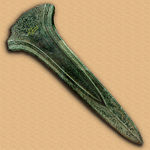History of materials science
Prehistory

In many cases, different cultures leave their materials as the only records; which

The innovation of smelting and casting metals in the Bronze Age started to change the way that cultures developed and interacted with each other. [citation needed] Starting around 5,500 BCE, early smiths began to re-shape native metals of copper and gold, without the use of fire and by using tools and weapons. The heating of copper and its shaping with hammers began around 5,000 BCE. [citation needed] Melting and casting started around 4,000 BCE. Metallurgy had its dawn with the reduction of copper from its ore around 3,500 BCE. The first alloy, bronze came into use around 3,000 BCE. [citation needed]
Stone Age
The use of materials began in the Stone Age. Typically, materials such as bone, fibers, feathers, shells, animal skin, and clay were used for weapons, tools, jewelry, and shelter. The earliest tools were in the paleolithic age, called Oldowan. These were tools created from chipped rocks that would be used for scavenging purpose.[citation needed] As history carried on into the Mesolithic age, tools became more complex and symmetrical in design with sharper edges. Moving into the Neolithic age, agriculture began to develop as new ways to form tools for farming were discovered. Nearing the end of the Stone Age, humans began using copper, gold, and silver as a material. Due to these metals' softness, the general use was for ceremonial purposes and to create ornaments or decorations and did not replace other materials for use in tools. The simplicity of the tools used reflected on the simple understanding of the human species of the time.[2]
Bronze Age
The use of copper had become very apparent to civilizations, such as its properties of elasticity and plasticity that allow it to be hammered into useful shapes, along with its ability to be melted and poured into intricate shapes. Although, the advantages of copper were many, the material was too soft to find large scale usefulness. Through experimentation or by chance, additions to copper lead to increased hardness of a new metal alloy, called bronze.[3] Bronze was originally composed of copper and arsenic, forming arsenic bronze.[4]
Iron Age
This section needs additional citations for verification. (July 2021) |
Antiquity

The use of asbestos as a material blossomed in Ancient Greece, especially when the fireproofing qualities of the material came to light. Many scholars believe the word asbestos comes from a Greek term, sasbestos, meaning inextinguishable or unquenchable.[7] Clothes for nobles, table clothes and other oven adornments were all furnished with a weave of the fibrous materials, as the materials could be cleansed by throwing them directly into fire.[8] The use of this material however was not without its downsides, Pliny the Elder, noted a link between the quick death of slaves to work in the asbestos mine. He recommended that slaves working in this environment use the a bladder skin as a makeshift respirator.[9]
After the
The use of cork, which has been recently added to the category of materials science, had its first mentions beginning with Horace, Pliny, and Plutarch.[10] It had many uses in antiquity including in fishing and safety devices because of its buoyancy, an engraving medium, sandal soles to increase stature, container stoppers, and being an insulator. It was also used to help cure baldness in the second century.[11]
In the Ancient Roman Era, glassblowing became an art involving the additions of decor and tints. They were also able to created complex shapes due to the use of a mold. This technology allowed them to imitate gemstones.[12] Window glass was formed by casting into flat clay molds then removed and cleaned.[12] The texture in stained glass comes from the texture the sand mold left on the side in contact with the mold.[12]
Polymeric composites also made an appearance during this time frame in the form of wood. By 80 BC, petrified resin and keratin were used in accessories as amber and tortoise shell respectively.[10]
In Alexandria in the first century BC, glass blowing was developed in part due to new furnaces that could create higher temperatures by using a clay coated reed pipe.[12] Plant ash and natron glass, the latter being the primary component, were used in blown pieces. Coastal and semi desert plants worked best due to their low magnesium oxide and potassium oxide content. The Levant, North Africa, and Italy were where blown glass vessels were most common.[13]
Middle Ages
Proto-porcelain material has been discovered dating back to the Neolithic period, with shards of material found in archaeological sites from the Eastern Han period in China. These wares are estimated to have been fired from 1260 °C to 1300 °C.
During the Early Middle Ages, the technique of creating windows steered more towards glass blowing non-tinted balls that were later flattened, but then in the late Middle Ages; the methodology returned to that from antiquity with a few minor adjustments, which included rolling with metallic rollers.[12]
In the 9th century,
Early modern period
In 1540,
In the 17th century,
In the 18th century,
In the 19th century,
Before the early 1800s,
In 1886, American
Material science as a field of study
Most fields of studies have a founding father, such as Newton in physics and Lavoisier in chemistry. Materials science on the other hand has no central figure.[22] In the 1940s, wartime collaborations of multiple fields of study to produce technological advances became a structure to the future field of study that would become known as material science and engineering.[23] During the Cold War in the 1950s, US President's Science Advisory Committee (PSAC) made materials a priority, when it realized that materials were the limiting factor for advances in space and military technology. In 1958, President Dwight D. Eisenhower created the Advanced Research Project Agency (ARPA),[24] referred to as the Defense Advanced Research Project Agency (DARPA) since 1996. In 1960, ARPA encouraged the establishment of interdisciplinary laboratories (IDL's) on university campuses, which would be dedicated to the research of materials, as well as to the education of students on how to conduct materials science research.[25] ARPA offered 4 year IDL contracts to universities, originally to Cornell University, University of Pennsylvania, and Northwestern University, eventually granting nine more contracts.[26] Although ARPA is no longer in control of the IDL program (the National Science Foundation took over the program in 1972 [26]), the original establishment of IDL's marked a significant milestone in the United States' research and development of materials science. Several institutions departments changed titles from "metallurgy" to "metallurgy and materials science" in the 1960s.[22][27]
Modern materials science
This section is missing information about almost everything. It needs to be rewritten or deleted. (March 2023) |
In the early part of the 20th century, most engineering schools had a department of metallurgy and perhaps of ceramics as well. Much effort was expended on consideration of the austenite - martensite - cementite phases found in the iron - carbon phase diagram that underlies steel production. [citation needed] The fundamental understanding of other materials was not sufficiently advanced for them to be considered as academic subjects. In the post WWII era, the systematic study of polymers advanced particularly rapidly. Rather than create new polymer science departments in engineering schools, administrators and scientists began to conceive of materials science as a new interdisciplinary field in its own right, one that considered all substances of engineering importance from a unified point of view. Northwestern University instituted the first materials science department in 1955.[28]
Richard E. Tressler was an international leader in the development of high temperature materials. He pioneered high temperature fiber testing and use, advanced instrumentation and test methodologies for thermostructural materials, and design and performance verification of ceramics and composites in high temperature aerospace, industrial and energy applications. He was founding director of the Center for Advanced Materials (CAM), which supported many faculty and students from the College of Earth and Mineral Science, the Eberly College of Science, the College of Engineering, the Materials Research Laboratory and the Applied Research Laboratories at Penn State on high temperature materials. His vision for interdisciplinary research played a key role in the creation of the Materials Research Institute. Tressler's contribution to materials science is celebrated with a Penn State lecture named in his honor.[29]
The
Silicon Age
This section may contain material not related to the topic of the article. (March 2023) ) |
The field of
See also
- Timeline of materials technology
- History of Ferrous Metallurgy
- History of hide materials
- History of silk
- Category:Materials scientists and engineers
References
- ISBN 978-0-387-26691-6.
- ^ Hummel, Rolf (2005). Understanding Materials Science History, Properties, Applications. pp. 1–2.
- ^ Hummel, Rolf. Understanding Materials Science: History, Properties, Application. p. 66.
- ^ Tylecote, R.F. History of Metallurgy, Second Edition. London: Manley Publishing, for the institute of metals.
- ISBN 978-1-4614-3523-5.
- ISBN 978-0-7277-2631-5.
- ^ "The History of Asbestos - Importing, Exporting & Worldwide Use". Mesothelioma Center - Vital Services for Cancer Patients & Families. Retrieved 2020-05-04.
- PMID 2088320.
- ^ "Greeks, Romans and Asbestos (a brief history of…)". Rearview Mirror. 2013-08-06. Retrieved 2020-05-04.
- ^ S2CID 137312591– via EBSCO Publishing.
- ISBN 9780080476865.
- ^ S2CID 138110010– via SpringerLink.
- ISBN 9781139611930.
- ISBN 978-0-500-23727-4.
- ^ "Porcelain in the Tang (618–906) and Song (960–1279) Dynasties". Archived from the original on 2018-03-16. Retrieved 2018-02-23.
- ^ )
- ISBN 0-8122-3554-1.
- ^ Geller, Tom (2 June 2016). "Aluminum: Common Metal, Uncommon Past". Science History Institute. Retrieved 4 May 2018.
- ^ "Production of Aluminum: The Hall-Héroult Process". American Chemical Society. Retrieved 4 May 2018.
- ISBN 978-0-8247-0896-2.
- ^ "Bayer's Process for Alumina Production: A Historical Production" (PDF). scs.illinois.edu. Fathi Habashi, Laval University. Retrieved 6 April 2018.
- ^ a b Vincent, Bernedetta. "Materials science and engineering: an artificial discipline about to explode". History of Recent Materials Science.
- ^ Olson, Gregory. "A Materials Science Timeline". Materials World Modules.
{{cite web}}: Missing or empty|url=(help) - ^ "DoD Directive Establishes the Advanced Research Projects Agency". www.darpa.mil. Retrieved 23 February 2018.
- ^ Psaras, Peter A. (1987). Advancing Materials Research. Washington, D.C.: National Academy Press. pp. 35–40.
- ^ a b "A Selected History of DARPA Innovation". DARPA. Retrieved February 23, 2018.
- ISBN 978-0-309-03697-9.
- ^ "About | Materials Science & Engineering | Northwestern Engineering".
- Penn State
- ^ Materials Research Society
- ^ See Cahn (2001) and Hentschel (2011) for further references and detailed analysis.
- ^ "100 incredible years of physics – materials science". Institute of Physics. December 2019. Archived from the original on 10 December 2019. Retrieved 10 December 2019.
Further reading
- Benvenuto Cellini (1500–1571) Autobiography.
- Galileo (1638) Two New Sciences, Leiden: Louis Elsevier.
- D. L. Weaire & C.G. Windsor (editors) (1987) Solid State Science: Past, Present and Predicted, ISBN 0-85274-584-2.
- Robert W. Cahn (2001) The Coming of Materials Science, Oxford: Pergamon Series.
- Klaus Hentschel (2011) Von der Werkstoffforschung zur materials science, in: Klaus Hentschel & Carsten Reinhardt (eds.) Zur Geschichte der Materialforschung, special issue of NTM 19,1 : 5-40.
External links
- 20th anniversary issue of MRS Bulletin from 1973.
- Northwestern University press release about 50th anniversary of its Materials Science Department in 2005.
- Materials Science at the American Chemical Society.
- Historical Metallurgy Society
- Plastics History Society
- Association for the History of Glass

